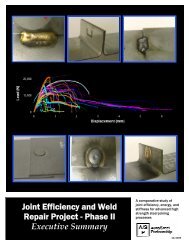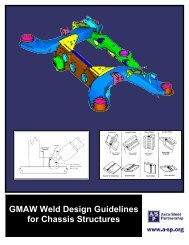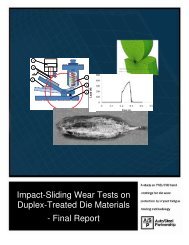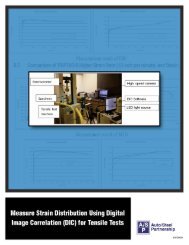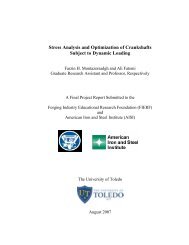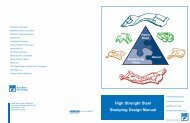Light Truck Frame Joint Stiffness Study Phase 1 Final Report
Light Truck Frame Joint Stiffness Study Phase 1 Final Report
Light Truck Frame Joint Stiffness Study Phase 1 Final Report
You also want an ePaper? Increase the reach of your titles
YUMPU automatically turns print PDFs into web optimized ePapers that Google loves.
APPENDIX A: ABSTRACTS<br />
6. Connection Element Method for the Analysis of Semi-Rigid <strong>Frame</strong>s<br />
Li, T.Q.; Choo, B.S.; and Nethercot, D.A.<br />
Journal of Constructional Steel Research; 1995<br />
A general procedure for incorporating the effects of joint flexibility into standard methods for the<br />
analysis of frames is presented. The method can allow for joint flexibility associated with all six<br />
degrees of freedom normally considered when analyzing three-dimensional frames, including<br />
coupling between deformations. It can also allow for the finite size and exact location of connections.<br />
Simple examples using the moment distribution technique, slope deflection equations and matrix<br />
stiffness method illustrate the application of the proposal. Additional examples to illustrate the effects<br />
of connection length on the frame moment distribution, lateral drift and column load capacities are<br />
also present.<br />
7. Determination of Rotation Capacity Requirements for Steel and Composite Beams<br />
Li, T.Q.; Choo, B.S.; and Nethercot, D.A.<br />
Journal of Constructional Steel Research; 1995<br />
A method is presented for the calculation of the necessary joint rotations to permit the use of moment<br />
redistribution as the basis for the design of semi-continuous steel and composite frames. The method<br />
is based on the use of moment-curvature relationships obtained from consideration of the basis steel<br />
and concrete stress-strain curves. It simplifies the determination of the support rotations required for<br />
specific percentage redistributions of support moments to the mid-span cross-section as used in EC4<br />
by considering these to be composed of an elastic and a plastic part. Several different load cases are<br />
considered, together with a wide range of beam properties. The resulting calculation method, which<br />
uses only formulae and graphs, is illustrated by an example.<br />
8. A Practical Method for Incorporation Flexible Connections in Plane <strong>Frame</strong> Analysis<br />
Lo, D.S.K and Stiemer, S.F.<br />
Canadian Journal of Civil Engineering<br />
A practical method for incorporating realistic flexible connections in plane frame analysis, including<br />
the effect of connection sizes and shear deflection, is presented. The general algorithm can be easily<br />
implemented in a standard plane frame analysis program and, one implemented, it can be an ideal<br />
tool for production work in the steel industry. Connection stiffness is programmed directly into the<br />
analysis using the moment-rotation equations developed by Frye and Morris or may be entered<br />
separately as data. Practical application of this method of analysis is demonstrated by modifying a<br />
standard plane frame analysis program to include the effect of flexible connections. Solutions<br />
obtained using this modified program, Plane, were verified against the findings of Moncarz and<br />
Gerstel. A simple plane frame structure was analyzed under various lateral load intensities for<br />
different connection assumptions. It was found that the inclusion of connection behavior significantly<br />
altered the internal force distribution and design of the structure.<br />
9. Behavior of Axially Loaded Tubular V-<strong>Joint</strong>s<br />
Scola, S.; Redwood, R.G.; and Mitri, H.S.<br />
Journal of Constructional Steel Research; 1990<br />
The results of an experimental test program comprising seven tubular V-joints and five tubular T-<br />
joints consisting of circular hollow sections and subject to branch axial loading are reported. The<br />
tested specimens has branch-to-chord diameter ratios varying from 0.22 to 0.65, and chord radius-tothickness<br />
ratios of 13 to 23. The angle between branches of the V-joints was 60, 90 or 120 degrees.<br />
The behavior of the joints is examined through a comparison of ultimate strengths, stiffness<br />
<strong>Report</strong>: A/SP-005-1 <strong>Light</strong> <strong>Truck</strong> <strong>Frame</strong> <strong>Joint</strong> <strong>Study</strong> 84



